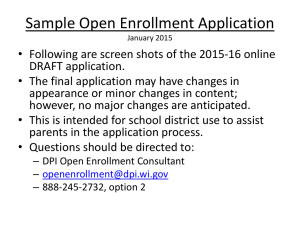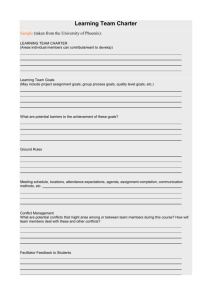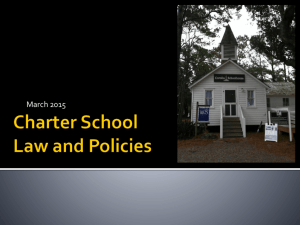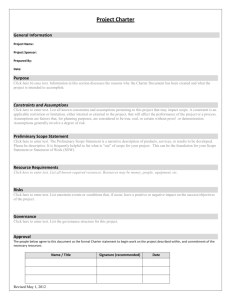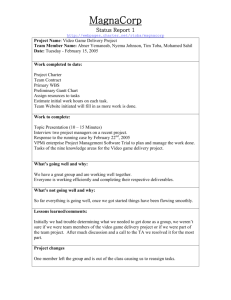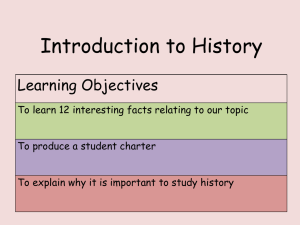2. Compliance Requirement – LEAs/charter schools are prohibited
advertisement
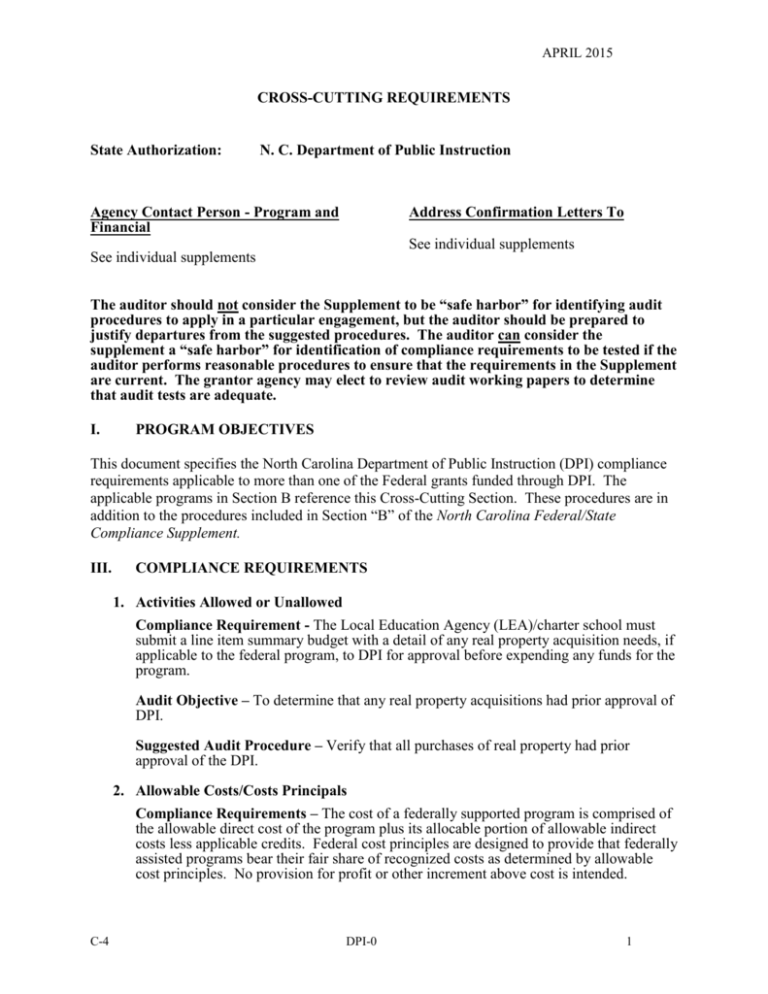
APRIL 2015 CROSS-CUTTING REQUIREMENTS State Authorization: N. C. Department of Public Instruction Agency Contact Person - Program and Financial Address Confirmation Letters To See individual supplements See individual supplements The auditor should not consider the Supplement to be “safe harbor” for identifying audit procedures to apply in a particular engagement, but the auditor should be prepared to justify departures from the suggested procedures. The auditor can consider the supplement a “safe harbor” for identification of compliance requirements to be tested if the auditor performs reasonable procedures to ensure that the requirements in the Supplement are current. The grantor agency may elect to review audit working papers to determine that audit tests are adequate. I. PROGRAM OBJECTIVES This document specifies the North Carolina Department of Public Instruction (DPI) compliance requirements applicable to more than one of the Federal grants funded through DPI. The applicable programs in Section B reference this Cross-Cutting Section. These procedures are in addition to the procedures included in Section “B” of the North Carolina Federal/State Compliance Supplement. III. COMPLIANCE REQUIREMENTS 1. Activities Allowed or Unallowed Compliance Requirement - The Local Education Agency (LEA)/charter school must submit a line item summary budget with a detail of any real property acquisition needs, if applicable to the federal program, to DPI for approval before expending any funds for the program. Audit Objective – To determine that any real property acquisitions had prior approval of DPI. Suggested Audit Procedure – Verify that all purchases of real property had prior approval of the DPI. 2. Allowable Costs/Costs Principals Compliance Requirements – The cost of a federally supported program is comprised of the allowable direct cost of the program plus its allocable portion of allowable indirect costs less applicable credits. Federal cost principles are designed to provide that federally assisted programs bear their fair share of recognized costs as determined by allowable cost principles. No provision for profit or other increment above cost is intended. C-4 DPI-0 1 CROSSCUTTING REQUIREMENTS APRIL 2015 OMB Circular No. A-87, “Cost Principles for State and Local Governments,” establishes principles and standards for determining costs applicable to grants, contracts, and other agreements with State and local governments and federally - recognized Indian Tribal governments. A cost is allowable for Federal reimbursement only to the extent of benefits received by Federal programs, and costs must meet the basic guidelines of allowability, reasonableness, allocability and remain the net of all applicable credits. (OMB Circular No. A-87 is issued under the authority of the Budget and Accounting Act of 1921, as amended; the Budget and Accounting Procedures Act of 1950, as amended; Reorganization Plan No. 2 of 1920; and, Executive Order 11541). Substitute systems for allocating salaries and wages to federal grants may be used only if approved by the cognizant agency. The substitute system authorized by DPI is the only substitute system approved for the LEAs/charter schools use. Audit Objective – To determine that the LEA/charter school had approval from DPI, Monitoring & Compliance Section to use a substitute system for allocating salaries and wages to federal grants and that the substitute system was authorized for use by the DPI. Otherwise the system detailed in OMB Circular A-87 must be used. Suggested Audit Procedures: Review in the Financial Policy and Procedures Manual for Local Education Agencies, Part Seventeen – Federal Budgets, Section 2, or for charter schools in documentation received from DPI, to determine the requirements for the substitute system authorized by DPI. Determine if the LEA/charter school used the OMB Circular A-87 system or the substitute system. If the substitute system was used, verify that approval was obtained from DPI. See http://www.ncpublicschools.org/docs/fbs/finance/federal/presentations/substitutesyste ms.pdf for a list of approved substitute systems. Report any deviations from the requirements of the system that was used. If in your review the deviation is greater than or equal to 10%, expand the sample to determine if the entire Time and Effort is off in its reporting. (Report methodology being used to track Time & Effort in footnotes). Report if a substitute system other than the system authorized by DPI was used. Verify that the necessary adjustments were made for any differences between the reported time and effort and how they were charged on payroll. 3. Cash Management Compliance Requirement – “Procedures for minimizing the time elapse between the transfer of funds from the U.S. Treasury and disbursement by grantees must be followed whenever advance payment procedures are used.” “Grantees must monitor cash drawdowns by their sub-grantees to assure that they conform substantially to the same standards of timing and amount as apply to advances to the grantees.” (34 CFR Part 80.20(7)) DPI must apply the following funding techniques as part of an agreement with the U. S. Treasury and the State of North Carolina: C-4 DPI-0 2 CROSSCUTTING REQUIREMENTS APRIL 2015 “The State shall request funds such that they are credited to a State account not more than two business days prior to the day the State makes a disbursement. The amount of the request shall be the amount the State expects to disburse.” (Agreement Between the State of North Carolina and the United States Department of the Treasury, Section 7.2) In accordance with the above requirements, DPI issues Cash Certification Calendars establishing deadlines for requesting funds to assist the LEAs/charter schools with their cash management efforts so that funds are deposited no more than two business days prior to the date of disbursement (3 day rule). These calendars display the last day to request funds for a particular Funds Requirement Date (date of intended disbursement). The LEAs/charter schools must enter requests for funds electronically into DPI’s Cash Management System for particular Funds Requirement Dates according to the deadlines established on the Cash Certification Calendar. DPI processes the requests so that the funds are received by DPI according to the above requirements and deposited after 2:00 p.m. into the respective LEA’s State Treasurer account the day before the Funds Requirement Date or the charter school’s local account on the Funds Requirement Date, once approval is received from the State Controller’s Office. Audit Objective – To determine that no more than two business days elapsed between the date the funds were deposited and the date of actual disbursement. Suggested Audit Procedures: Based on a sample of disbursement dates, determine that funds were received no more than two business days prior to the date of disbursement. Verify that bank reconciliations are performed on a periodic basis and that monthly balances are reconciled to the G/L. 6. Equipment and Real Property Management 1. Compliance Requirement - The LEA/charter school must submit a line item summary budget with a detail of any equipment and real property acquisition needs to DPI for approval before expending any of the program funds. Prior approval is required for equipment costing $5,000 or more and a FPD210-A (Equipment Summary Form) must be submitted to DPI for those units not using the Budget Utilization and Development System. Audit Objective – To determine that equipment purchases costing $5,000 or more received prior approval from DPI. Suggested Audit Procedure – Identify all equipment purchases of $5,000 or more and verify that the LEA/charter school had prior approval of DPI. 2. Compliance Requirement – All assets such as moveable equipment should be recorded on the LEA’s/charter school’s fixed asset system according to the LEA’s/charter school’s capitalization policy, available from the finance officer or assets manager. Audit Objective – To determine that asset acquisitions such as moveable equipment were recorded and coded by PRC on the LEA’s/charter school’s fixed asset system according to the LEA’s/charter school’s capitalization policy. C-4 DPI-0 3 CROSSCUTTING REQUIREMENTS APRIL 2015 Suggested Audit Procedures: Review LEA’s/charter school’s fixed asset report and their capitalization policy. Determine that asset acquisitions such as moveable equipment were recorded on the LEA’s/charter school’s fixed asset system according to the LEA’s/charter school’s capitalization policy. 9. Procurement and Suspension and Debarment 1. Compliance Requirement – Obligations must be incurred in accordance with state purchasing requirements. (G.S. 143-48 through 143-64.5) Audit Objective – To determine that obligations were incurred in accordance with state purchasing requirements. Suggested Audit Procedures: Select a sample of general expenditure disbursements made from the appropriate Federal Grant Fund: Determine that purchases met the state purchasing requirements found in G.S. 143-48 through 143-64.5. 2. Compliance Requirement – LEAs/charter schools are prohibited from entering into a contract with a party that has been suspended or debarred by the State of North Carolina. Audit Objective – To determine that the LEA/charter school has not entered into a contract with a party that has been suspended or debarred by the State of North Carolina. Suggested Audit Procedure – Verify that the LEA/charter school has not entered into a contract with a party that has been suspended or debarred by the State of North Carolina. A list of debarred parties can be found at: http://www.doa.state.nc.us/PandC/actions.htm. 3. Compliance Requirement – LEAs/charter schools are prohibited from using federal funds for a procurement transaction with a party that has been suspended or debarred by the federal government. Audit Objective – To determine that the LEA/charter school has not used federal funds for a procurement transaction with a party that has been suspended or debarred by the federal government. Suggested Audit Procedure – Verify that the LEA/charter school has not used federal funds for a procurement transaction with a party that has been suspended or debarred by the federal government. A list of debarred parties can be found at: https://www.sam.gov/. 12. Reporting Compliance Requirements – The U. S. Department of Education Cross-Cutting section requires that the LEA/charter school report financial information to the State Education Agency (SEA). C-4 DPI-0 4 CROSSCUTTING REQUIREMENTS APRIL 2015 The N. C. General Statutes require that the LEA/charter school shall comply with the reporting requirements established by the State Board of Education in the Uniform Education Reporting System (UERS) (G.S. 115C-12(18)). The UERS requires that the LEA/charter school shall report fiscal, personnel, and student data by means of electronic transfer of data files from local computers to the State Computer Center through the State Communications Network on a schedule developed by the State Board of Education, currently monthly. The request for funds is also processed electronically as discussed in the Cash Management section of this supplement. The reporting of fiscal, personnel, and student data by means of electronic transfer of data files from local computers to the State Computer Center through the State Communications Network on a schedule developed by the State Board of Education is monitored by the Division of School Business at the Department of Public Instruction. The local auditor is not required to test for compliance with this requirement. 14. Special Tests and Provisions 1. Compliance Requirement – Budget amendments are required if a LEA/charter school has exceeded the cumulative budgeted line items by 10% or more of their current total approved budget. These amendments are submitted through the BUD system by LEAs, on form FPD 209 by charter schools, and approved by the individual program consultant at DPI. Audit Objective – Determine that an approved budget amendment was submitted if the total over-expended line items are 10% or more of the total approved budget. Suggested Audit Procedures: Review the approved budget and amendments to determine the total approved budget, compare the LEAs or Charter Schools’ budget on BUD by line item to expenditures on JHA 305/JHA 705 reports to determine any over-expended line items. Verify that a budget amendment was submitted and approval received if the total over-expended line items are 10% or more of the total approved budget. 2. Compliance Requirement – The portion of any sales tax refunds received that pertain to the Federal Funds administered by DPI must be refunded to the appropriate Federal Program that paid the sales tax. Audit Objective – To determine that the portion of any sales tax refunds received that pertain to the Federal Funds administered by DPI were refunded to the appropriate Federal Program that paid the sales tax. Suggested Audit Procedures: Review any sales tax refunds received and supporting documentation for the refund request. Determine that all refunds received that pertain to any Federal Program administered by DPI have been posted to the appropriate program. 3. Compliance Requirement – No Child Left Behind Act of 2001(NCLB) amends the Elementary and Secondary Education Act of 1965 (ESEA) and replaces the Improving C-4 DPI-0 5 CROSSCUTTING REQUIREMENTS APRIL 2015 America’s School Act of 1994 (IASA). Under NCLB, all teachers who teach in a core academic area must meet highly qualified criteria, as defined in the law, (Section 1119 of NCLB) by June 30, 2006. These teachers must meet the requirements for full certification and have demonstrated competency in each of the subjects that they teach. Beginning in the fall of 2002, all newly-hired teachers working in programs supported by Title I funds had to meet NCLB’s definition of highly qualified. Highly qualified means that public elementary and secondary teachers must be fully licensed and certified in their subject by the state and must not have had any certification or licensure requirements waived on an emergency, temporary or provisional basis. In 2001-02, North Carolina School systems were required to develop plans for ensuring that all teachers in core subject areas meet the definition of highly qualified no later than June 30, 2006. Paraprofessionals performing instructional duties and working in programs supported by Title I funds on or before Jan. 8, 2002, must become highly qualified on or before Jan. 8, 2006. They must work under direct supervision of a highly qualified teacher and have at least a high school diploma or its equivalent. Paraprofessionals working primarily in translation or solely in parent involvement activities must meet the requirements for a high school diploma or its equivalent; however, paraprofessionals who do not perform any instructional duties are exempt from the requirements. Newly-hired (after Jan. 8, 2002) paraprofessionals performing instructional duties working in programs supported by Title I funds must already have: (1) a high school diploma and at least two years of college, (2) have an associate’s degree or higher, (3) have met a rigorous standard of quality and demonstrated through state/local formal assessment knowledge of and the ability to assist in instructing reading, writing and mathematics. Paraprofessionals not working in programs supported by Title I funds are not affected by the federal legislation. For additional information go to http://www.ncp7ublicschools.org/nclb. Audit Objective – To determine if teachers and paraprofessional paid with Title I funds meet the qualifications set by No Child Left Behind (NCLB) legislation. Suggested Audit Procedure: Review licensure records to determine if teachers and paraprofessional paid with Title I funds meet the requirements of NCLB. 1. Review Title I fund expenditures for Teacher or Paraprofessional payroll expenses. 2. Determine hire date of Title I teachers and paraprofessionals. 3. Review licensure certifications to determine if qualifications have been met for teachers and that paraprofessionals have: (1) a high school diploma and at least two years of college, (2) have an associate’s degree or higher, (3) have met a rigorous standard of quality and demonstrated through state/local formal assessment. C-4 DPI-0 6
